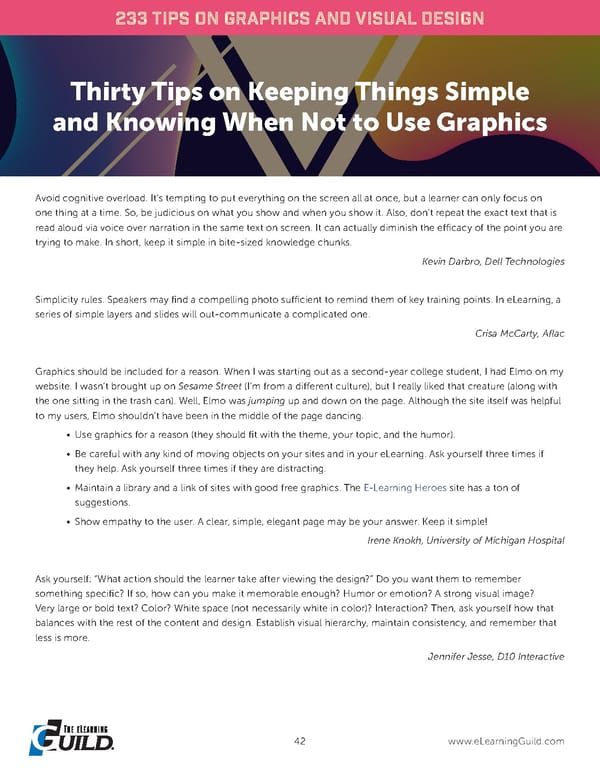233 TIPS Graphics and Visu De al sign 233 TIPS ON GRAPHICS AND VISUAL DESIGN Thirty Tips on Keeping Things Simple and Knowing When Not to Use Graphics Avoid cognitive overload. It’s tempting to put everything on the screen all at once, but a learner can only focus on one thing at a time. So, be judicious on what you show and when you show it. Also, don’t repeat the exact text that is read aloud via voice over narration in the same text on screen. It can actually diminish the efficacy of the point you are trying to make. In short, keep it simple in bite-sized knowledge chunks. Kevin Darbro, Dell Technologies Simplicity rules. Speakers may find a compelling photo sufficient to remind them of key training points. In eLearning, a series of simple layers and slides will out-communicate a complicated one. Crisa McCarty, Aflac Graphics should be included for a reason. When I was starting out as a second-year college student, I had Elmo on my website. I wasn’t brought up on Sesame Street (I’m from a different culture), but I really liked that creature (along with the one sitting in the trash can). Well, Elmo was jumping up and down on the page. Although the site itself was helpful to my users, Elmo shouldn’t have been in the middle of the page dancing. • Use graphics for a reason (they should fit with the theme, your topic, and the humor). • Be careful with any kind of moving objects on your sites and in your eLearning. Ask yourself three times if they help. Ask yourself three times if they are distracting. • Maintain a library and a link of sites with good free graphics. The E-Learning Heroes site has a ton of suggestions. • Show empathy to the user. A clear, simple, elegant page may be your answer. Keep it simple! Irene Knokh, University of Michigan Hospital Ask yourself: “What action should the learner take after viewing the design?” Do you want them to remember something specific? If so, how can you make it memorable enough? Humor or emotion? A strong visual image? Very large or bold text? Color? White space (not necessarily white in color)? Interaction? Then, ask yourself how that balances with the rest of the content and design. Establish visual hierarchy, maintain consistency, and remember that less is more. Jennifer Jesse, D10 Interactive 42 www.eLearningGuild.com
 233 Tips on Graphics and Visual Design Page 44 Page 46
233 Tips on Graphics and Visual Design Page 44 Page 46